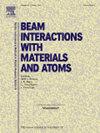A new graphitization setup for radiocarbon dating using accelerator mass spectrometer at Physical Research Laboratory Ahmedabad
IF 1.4
3区 物理与天体物理
Q3 INSTRUMENTS & INSTRUMENTATION
Nuclear Instruments & Methods in Physics Research Section B-beam Interactions With Materials and Atoms
Pub Date : 2025-04-09
DOI:10.1016/j.nimb.2025.165698
引用次数: 0
Abstract
A new vacuum system for radiocarbon (14C) dating has been developed at the Physical Research Laboratory (PRL), Ahmedabad. This system uses zinc as a reducing agent and iron powder as a catalyst to convert CO2 into graphite, which is then analyzed using Accelerator Mass Spectrometry (AMS) for measuring 14C content. The system efficiently processes CO2 from wide range of samples including organic material, carbonates and water. In this paper, we discuss the details of the setup, graphite reduction efficiency, background activity, and measurements of oxalic acid standards alongside 14C determinations from known international standards. Additionally, the paper outlines the data reduction process for AMS and the procedure for reporting radiocarbon content with uncertainties. The system can handle five samples at a time, with CO2 reduction efficiency ranging from 50 to 100%. Multiple 14C age measurements from 12 international standards highlight the system’s precision and reliability.
艾哈迈达巴德物理研究实验室使用加速器质谱仪进行放射性碳测年的新型石墨化装置
位于艾哈迈达巴德的物理研究实验室(PRL)开发了一种新的放射性碳(14C)定年真空系统。该系统使用锌作为还原剂,铁粉作为催化剂将二氧化碳转化为石墨,然后使用加速器质谱(AMS)对其进行分析,以测量14C含量。该系统有效地处理各种样品中的二氧化碳,包括有机物质、碳酸盐和水。在本文中,我们讨论了设置的细节,石墨还原效率,背景活度,以及草酸标准的测量以及已知国际标准的14C测定。此外,本文概述了AMS的数据缩减过程和报告不确定放射性碳含量的程序。该系统一次可处理5个样品,二氧化碳减排效率从50%到100%不等。来自12个国际标准的多个14C年龄测量突出了系统的精度和可靠性。
本文章由计算机程序翻译,如有差异,请以英文原文为准。
求助全文
约1分钟内获得全文
求助全文
来源期刊
CiteScore
2.80
自引率
7.70%
发文量
231
审稿时长
1.9 months
期刊介绍:
Section B of Nuclear Instruments and Methods in Physics Research covers all aspects of the interaction of energetic beams with atoms, molecules and aggregate forms of matter. This includes ion beam analysis and ion beam modification of materials as well as basic data of importance for these studies. Topics of general interest include: atomic collisions in solids, particle channelling, all aspects of collision cascades, the modification of materials by energetic beams, ion implantation, irradiation - induced changes in materials, the physics and chemistry of beam interactions and the analysis of materials by all forms of energetic radiation. Modification by ion, laser and electron beams for the study of electronic materials, metals, ceramics, insulators, polymers and other important and new materials systems are included. Related studies, such as the application of ion beam analysis to biological, archaeological and geological samples as well as applications to solve problems in planetary science are also welcome. Energetic beams of interest include atomic and molecular ions, neutrons, positrons and muons, plasmas directed at surfaces, electron and photon beams, including laser treated surfaces and studies of solids by photon radiation from rotating anodes, synchrotrons, etc. In addition, the interaction between various forms of radiation and radiation-induced deposition processes are relevant.

 求助内容:
求助内容: 应助结果提醒方式:
应助结果提醒方式:


